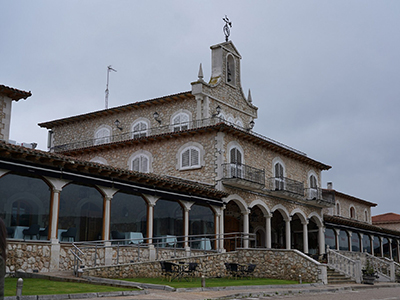Arzuaga Navarro
Ctra, N-122 Aranda-Valladolid, km. 325., 47350, Quintanilla de Onésimo, (Valladolid) , Spain
arzuaganavarro.com
Established in the 1990s, the story of this leading winery in Ribera del Duero began when businessman Florentino Arzuaga acquired La Planta, a 1,400-hectare estate situated on the region’s páramo (high plateau) at 900 metres elevation in Quintanilla de Onésimo (Valladolid). The plan was completed with the construction of a bodega in the “Golden Mile”, a small strip of the N-122 road known for the high density of famous wineries.
The second generation now runs the business. Ignacio Arzuaga is in charge of the wines, whereas his sister Amaya left behind a successful career as an entrepreneur and fashion designer to run the five-star spa hotel and its Michelin-starred restaurant Taller Arzuaga.
Arzuaga has become a leading wine tourism destination in Ribera del Duero, both for its accommodation and dining offer, as well as for its tours of La Planta. In addition to its 70 hectares of vineyards in the heart of the estate, visitors can spot dozens of deer and wild boar and have their photos taken by the colossal holm oak, said to be one thousand years old, that lends its name to the estate.
With 377 hectares set to be farmed in a few years' time, Arzuaga is on its way to establishing itself as one of the leading vineyard holders in the DO. In addition to La Planta vineyard and other sites surrounding the winery, the house owns several plots on hillsides descending from the plateau like Barquillo in Quintanilla de Onésimo, one of the few terraced vineyards in Ribera, or La Quemada, a 34-hectare site along the opposite bank of the valley, in Olivares de Duero.
Most of the recently planted vineyards lie on this village’s plateau. Starting in 2018, they now cover 235 hectares, all of which are organically farmed. Elevation is similar to La Planta (905-920 m above sea level) and soils are slightly deeper, albeit the area is generally known for its shallow, poor terrain and barren, flat and often unsheltered land. Despite the challenges, the vineyards benefit from radical temperature drops during the night and excellent aeration -it’s not by chance that the estate is called Buenos Aires (good air, in Spanish).
Plantings on the páramo require painstaking preparatory work. This involves removing a large number of stones and the use of specific equipment to dig holes deep enough for the vines to firmly sink their roots during the early years of their life.
The bodega also buys grapes from local growers, many of whom have been supplying Arzuaga for over two decades. Most of them are based in the Burgos province, which is an important source of old vineyards.
The range of wines is very wide. There is a collection of straightforward wines which are either sold with a separate brand or with a discreet mention of the Arzuaga name. It includes Fan d'Oro (€12, 30,000 bottles), made from Chardonnay vines grown at La Planta and without the DO seal; Rosae Arzuaga (€11, 30,000 bottles), a directly pressed rosé made from early-harvested Tempranillo grapes also from La Planta; and most notably La Planta (over 1.2m bottles, €8.5). This light and fresh entry-level red is aged for six months in barrels and makes the most of Arzuaga's high-elevation vineyards. Laderas del Norte (just under 30,000 bottles, €) is the house's first organic wine, exclusively sold to the on-trade. In this case, grapes are sourced from Valdesardón, a hillside plot on white limestone soils in Olivares de Duero which the winery claims it is the westernmost vineyard in Ribera del Duero.
The classic Arzuaga range usually blends around 5% to 10% of Cabernet Sauvignon and, in the premium cuvées, increasing amounts of grapes sourced from old vineyards in Burgos. From the Reserva upwards, all of the wines are aged in French oak. In the case of the Crianza (€19, 550,000 bottles) 25% is aged in American oak. It is balanced and approachable, in contrast with the Reserva (30 months in barrels, 75,000 bottles, €37), which needs some cellaring. With a shorter time in barrel, the Reserva Especial (24 months, 6,000 bottles, €54) has a firm body, fine texture and complex nose and is one of Arzuaga’s top wines. At the other end in terms of style, the Gran Reserva (€82, 5,000 bottles) feels more mature and developed after spending 56 months in barrels.
Made in limited quantities, the top Gran Arzuaga (€140, fewer than 1,000 bottles) and Amaya Arzuaga (fewer than 3,000 bottles, €65) are the result of co-fermenting Tempranillo with 5% of the local white variety Albillo Mayor. While the first is a mineral, terroir-driven red with powerful fruit and a herbal background, Amaya Arzuaga is more modern and a bit wild (whole-cluster fermentation may help), yet it feels finely-textured and approachable.
Total production stands at 2m bottles. Adolfo González is in charge of winemaking.
Most popular
NEWSLETTER
Join our community of Spanish wine lovers


